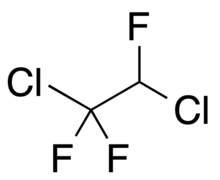Chemistry:1,2-Dichloro-1,1,2-trifluoroethane
From HandWiki

| |
| Names | |
|---|---|
| Preferred IUPAC name
1,2-Dichloro-1,1,2-trifluoroethane | |
| Other names
R-123a
| |
| Identifiers | |
3D model (JSmol)
|
|
| ChemSpider | |
| EC Number |
|
PubChem CID
|
|
| UNII | |
| UN number | 3163 1078 |
| |
| |
| Properties | |
| C2HCl2F3 | |
| Molar mass | 152.93 g·mol−1 |
| Density | 1.50 |
| Melting point | −78.0 °C (−108.4 °F; 195.2 K) |
| Boiling point | 29.5 °C (85.1 °F; 302.6 K) |
| Vapor pressure | 620.01 mmHg |
Henry's law
constant (kH) |
9.55×10−2 atm-cu m/mole |
Refractive index (nD)
|
1.327 |
Except where otherwise noted, data are given for materials in their standard state (at 25 °C [77 °F], 100 kPa). | |
| Infobox references | |
1,2-Dichloro-1,1,2-trifluoroethane is a volatile liquid chlorofluoroalkane composed of carbon, hydrogen, chlorine and fluorine, and with structural formula CClF2CHClF. It is also known as a refrigerant with the designation R-123a.[1]
Formation
1,1,2-Trichloro-1,2,2-trifluoroethane can be biotransformed in sewage sludge to 1,2-dichloro-1,1,2-trifluoroethane.[2]
Properties
The critical temperature of R-123a is 461.6 K (188.5 °C; 371.2 °F).[3] The rotation of the molecule appears to be hindered by the present of chlorine on each carbon atom, but is eased at higher temperatures.[3]
Use
Although not deliberately used, R-123a is a significant impurity in its isomer, the widely used 2,2-dichloro-1,1,1-trifluoroethane (R-123).[3]
References
- ↑ Kubota, H.; Yamashita, T.; Tanaka, Y.; Makita, T. (May 1989). "Vapor pressures of new fluorocarbons". International Journal of Thermophysics 10 (3): 629–637. doi:10.1007/BF00507984. Bibcode: 1989IJT....10..629K.
- ↑ "Reductive dechlorination of CFCs and HCFCs under methanogenic conditions". 10 January 2005. https://kobo.ch/balsiger/cv/publications/battelle/cfcs.pdf. Retrieved 15 July 2020.
- ↑ 3.0 3.1 3.2 Goodwin, A. R. H.; Moldover, M. R. (October 1991). "Thermophysical properties of gaseous refrigerants from speed-of-sound measurements. III. Results for 1,1-dichloro-2,2,2-trifluoroethane (CHCl2-CF3) and 1,2-dichloro-1,2,2-trifluoroethane (CHClF-CClF2)". The Journal of Chemical Physics 95 (7): 5236–5242. doi:10.1063/1.461831. Bibcode: 1991JChPh..95.5236G.
External links
- OKADA, Masaaki (2 December 1995). "代替冷媒の表面張力" (in ja). Trans. of the JAR 12 (2): 135–145. doi:10.11322/tjsrae.12.135. https://www.jstage.jst.go.jp/article/tjsrae/12/2/12_2_135/_article/-char/ja/.

 |

